Seats decomposition
Seats is an ARIMA Model Based (AMB) decomposition which is the second part of Tramo-Seats seasonal adjustment algorithm, originally developed by the Bank of Spain.
Seats is a program for estimating unobserved components in a time series. It follows the ARIMA-model-based (AMB) method, developed from the work of CLEVELAND, W.P., and TIAO, G.C. (1976), BURMAN, J.P. (1980), HILLMER, S.C., and TIAO, G.C. (1982), BELL, W.R., and HILLMER, S.C. (1984) and MARAVALL, A., and PIERCE, D.A. (1987).
(up coming here compact reference)
In recent years, Seats implementation in JDemetra+ v 3.x has been extended to infra-monthly data (weekly, daily, hourly…). Handling this kind of data gave way to a tailored AMB decomposition whose peculiarities are described in this chapter.
In this chapter
This chapter provides details on seats algorithm steps.
The practical implementation as well as all the options, using the graphical user interface or R packages are described in this chapter
Seats steps
Seats decomposes the linearized series into trend, seasonal, transitory and irregular components, provides forecasts for these components, together with the associated standard errors, and finally assign the deterministic effects to each component yielding the final components.
Input from Tramo
In JDemetra+ the input for the model based signal extraction procedure is always provided by Tramo and includes the original series
ARIMA modelling of the input series
One of the fundamental assumptions made by Seats is that the linearized time series
where:
It should be noted that the stochastic time series can be predicted using its past observations and making an error. The variable
Denoting
where
Derivation of the models for the components
Let us consider the additive decomposition model
where i refers to the orthogonal components: trend, seasonal, transitory or irregular. Apart from the irregular component, supposed to be a white noise, it is assumed that each component follows the ARIMA model which can be represented, using the notation of Equation 2 as:
where
These disturbances are functions of the innovations in the series and are called “pseudo-innovations” in the literature concerning the AMB decomposition as they refer to the components that are never observed In the JDemetra+ documentation the term “innovations” is used to refer to “pseudo-innovations”.(GÓMEZ, V., and MARAVALL, A. (2001a).
The following assumptions hold for Equation 4. For each
For description of the spectrum see chapter on Spectral Analysis.(MARAVALL, A. (1995).
Since aggregation of ARIMA models yields ARIMA models, the series
In the ARIMA model based approach implemented in Seats, the ARIMA model identified and estimated for the observed series
while the MA polynomials for the components, together with the innovation variances
where
To understand how Seats factorizes the AR polynomials, first a concept of a root will be explored.(Description based on KAISER, R., and MARAVALL, A. (2000) and MARAVALL, A. (2008c).)
Equation 2 can be expressed as:
Let us now consider Equation 2 in the inverted form:
If both sides of Equation 8 multiplied by
where
The autocorrelation function
If
and will converge to zero as
it can be derived that
Equation 11 has real and complex roots (solutions). Complex number
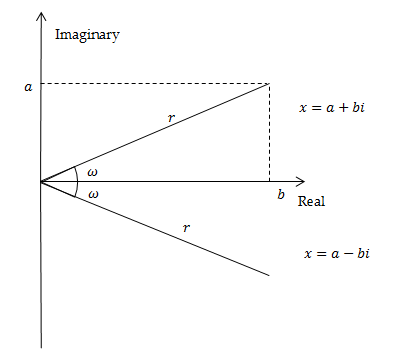
Representing the roots of the characteristic Equation 11 in the complex plane enhances understanding how they are allocated to the components. When the modulus
The characteristic equations associated with the regular and the seasonal differences have roots in
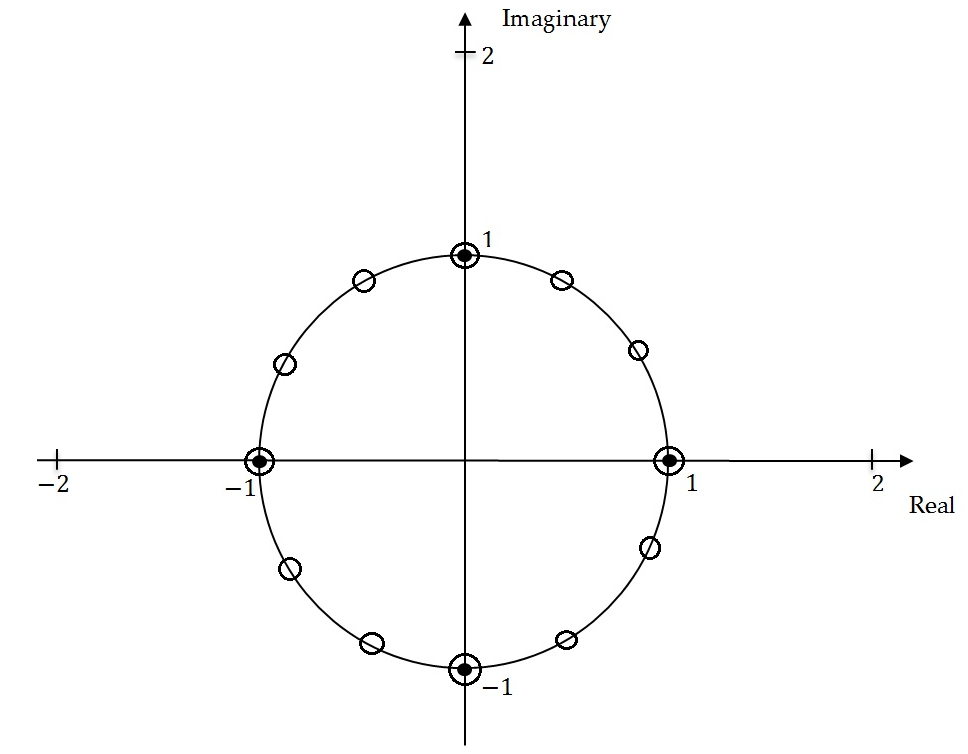
For the seasonal differencing operator
The complex conjugates roots generate the periodic movements of the type:
where:
The frequency
For quarterly series the seasonal movements are produced by complex conjugates roots with angular frequencies at
Seasonal frequencies for a quarterly time series
| Angular frequency ( |
Frequency (cycles per unit time) ( |
Cycles per year | Length of the movement measured in quarters ( |
|---|---|---|---|
| 0.25 | 1 | 4 | |
| 0.5 | 2 | 2 |
For monthly time series the seasonal movements are produced by complex conjugates roots at the angular frequencies:
Seasonal frequencies for a monthly time series
| Angular frequency ( |
Frequency (cycles per time unit) ( |
Cycles per year | Length of the movement measured in months ( |
|---|---|---|---|
| 0.083 | 1 | 12 | |
| 0.167 | 2 | 6 | |
| 0.250 | 3 | 4 | |
| 0.333 | 4 | 3 | |
| 0.417 | 5 | 2.4 | |
| 0.500 | 6 | 2 |
In JDemetra+ Seats assigns the roots of the AR full polynomial to the components according to their associated modulus and frequency (For details see MARAVALL, A., CAPORELLO, G., PÉREZ, D., and LÓPEZ, R. (2014))
Roots of
Roots of
When the modulus of the inverse of a real positive root of
Real negative inverse roots of
Complex roots, for which the argument (angular frequency) is close enough to the seasonal frequency are assigned to the seasonal component. Closeness is controlled by the Seasonal tolerance and Seasonal tolerance (unique) parameters. Otherwise they are assigned to the transitory component.
If
It should be highlighted that when
Once these rules are applied, the factorization of the AR polynomial presented by Equation 2 yields to the identification of the AR polynomials for the components which contain, respectively, the AR roots associated with the trend component, the seasonal component and the transitory component.
The AR roots close to or at the trading day frequency generates a stochastic trading day component. A stochastic trading day component is always modelled as a stationary ARMA(2,2), where the AR part contains the roots close to the TD frequency, and the MA(2) is obtained from the model decomposition (MARAVALL, A., and PÉREZ, D. (2011)). This component, estimated by Seats, is not implemented by the current version of JDemetra+.
Then with the partial fraction expansion the spectrum of the final components are obtained.
For example, the Airline model for a monthly time series:
is decomposed by Seats into the model for the trend component:
and the model for the seasonal component:
As a result, the Airline model is decomposed as follows:
The transitory component is not present in this case and the irregular component is the white noise.
The partial fractions decomposition is performed in a frequency domain. In essence, it consists in portioning of the pseudo-spectrum of
Therefore, the MA polynomials and the innovation variances cannot be yet identified from the model of
Given the stochastic features of the series, it can be shown by that the canonical decomposition produces as stable as possible trend and seasonal components since it maximizes the variance of the irregular and minimizes the variance of the other components. However, there is a price to be paid as canonical components can produce larger revisions in the preliminary estimators of the component than any other admissible decomposition.
The term pseudo-spectrum is used for a non-stationary time series, while the term spectrum is used for a stationary time series.
If the ARIMA model estimated in Tramo does not accept an admissible decomposition, Seats replaces it with a decomposable approximation. The modified model is therefore used to decompose the series. There are also other rare situations when the ARIMA model chosen by Tramo is changed by Seats. It happens when, for example, the ARIMA models generate unstable seasonality or produce a senseless decomposition. Such examples are discussed by MARAVALL, A. (2009).
HILLMER, S.C., and TIAO, G.C. (1982).
GÓMEZ, V., and MARAVALL, A. (2001a).
HILLMER, S.C., and TIAO, G.C. (1982).
MARAVALL, A. (1986).
The figure below represents the pseudo-spectrum for the canonical trend and an admissible trend.
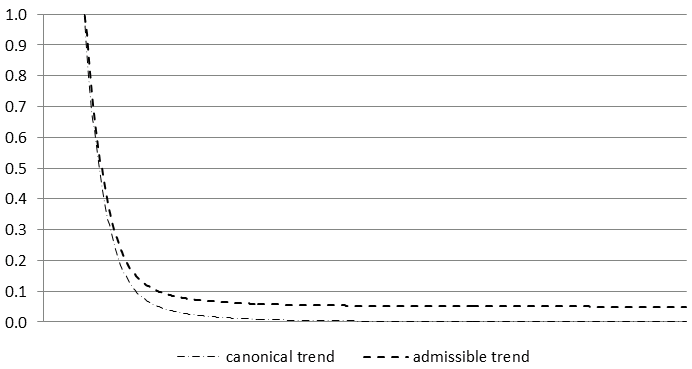
A pseudo-spectrum is denoted by
where:
A pseudo-spectrum for a monthly time series
The frequencies in the range
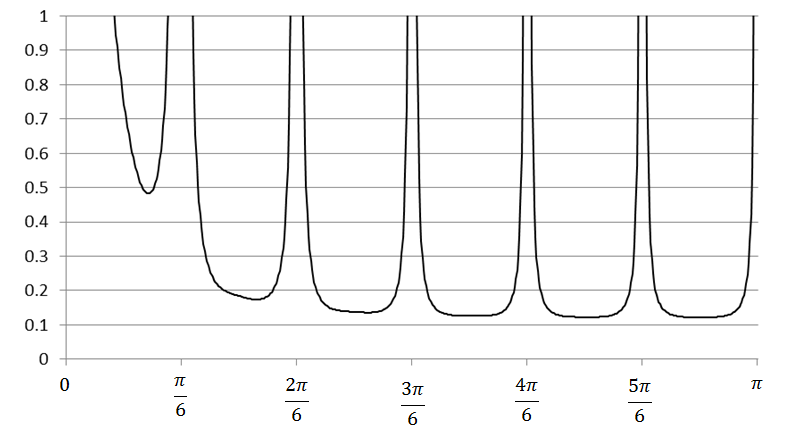
In the decomposition procedure, the pseudo-spectrum of the time series
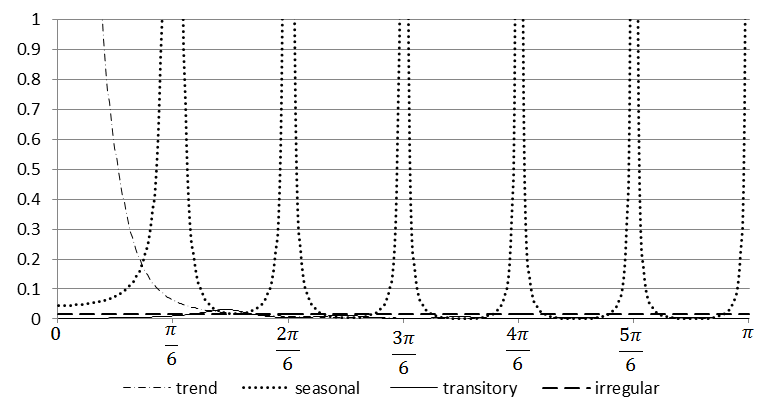
Estimation of the components
The various components are estimated using Wiener-Kolmogorow (WK) filters. JDemetra+ includes three options to estimate the WK filter, namely Burman, KalmanSmoother and MCElroyMatrix[^m-seats-decomposition_old-12]. Here the first of above mentioned options, proposed by BURMAN, J.P. (1980) will be explained.
The estimation procedure and the properties of the WK filter are easier to explain with a two-component model. Let the seasonally adjusted series (
and
From Equation 6 and Equation 7 it is clear that
As the time series components are never observed, their estimators have to be used. Let us note
where
Expressing the
where:
is a WK filter.
Equation 24 shows that the WK filter is two-sided (uses observations both from the past and from the future), centred (the number of points in the past is the same as in the future) and symmetric (for any
The estimator can be presented as
where
The example of the WK filters obtained for the pseudo-spectra of the series illustrated above is shown on the figure below: WK filters for components.
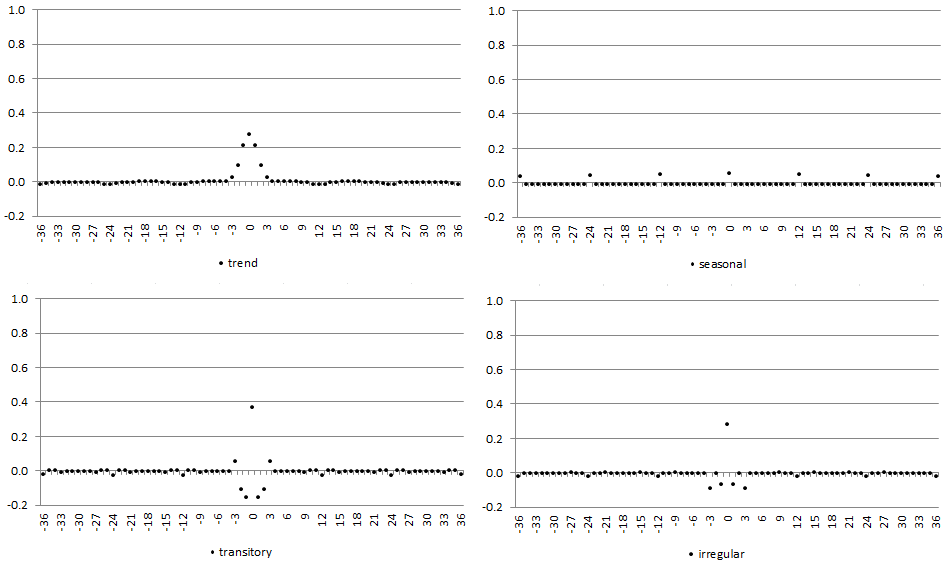
The WK filter from Equation 24 can also be expressed as a ratio of two pseudo-autocovariance generating functions (p-ACGF). The p-ACGF function summarizes the sequence of absolutely summable autocovariances of a stationary process
The ACGF function of an ARIMA process is expressed as:
And, the WK filter can be rewritten as:
where:
From Equation 24 it can be seen that the WK filter depends on both the component and the series models. Consequently, the estimator of the component and the WK filter reflect the characteristic of data and by construction, the WK filter adapts itself to the series under consideration. Therefore, the ARIMA model is of particular importance for the Seats method. Its misspecification results in an incorrect decomposition.
This adaptability, if the model has been correctly determined, avoids the dangers of under and overestimation with an ad-hoc filtering. For example, for the series with a highly stochastic seasonal component the filter adapts to the width of the seasonal peaks and the seasonally adjusted series does not display any spurious seasonality. Examples of WK filters for stochastic and stable seasonal components are presented on the figure below. (MARAVALL, A. (1995)).

The derivation of the components requires an infinite realization of
When

In the frequency domain, the Wiener-Kolmogorov filter
The function
The spectrum of the estimator of the seasonal component is expressed as:
where
For each
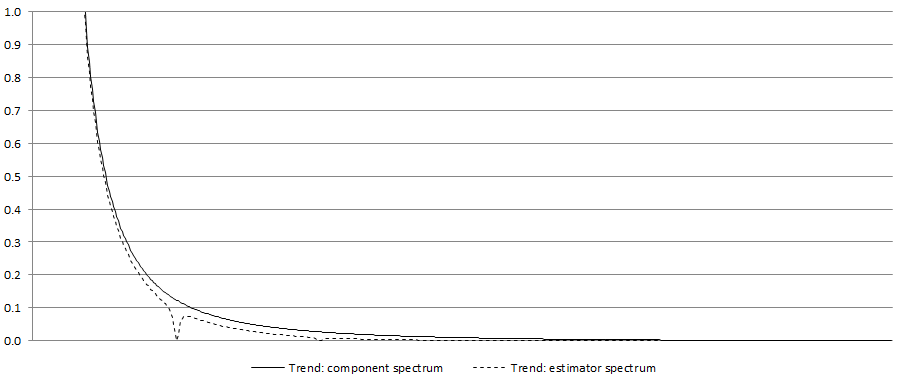
From the Equation 29 it is clear that the squared gain of the filter determines how the variance of the series contributes to the variance of the seasonal component for the different frequencies. When

Since
Since
Preliminary estimators for the components
GÓMEZ, V., and MARAVALL, A. (2001a) point out that the properties of the estimators have been derived for the final (or historical) estimators. For a finite (long enough) realization, they can be assumed to characterize the estimators for the central observations of the series, but for periods close to the beginning of the end the filter cannot be completed and some preliminary estimator has to be used. Indeed, the historical estimator shown in Equation 28 is obtained for the central periods of the series. However, when
To introduce preliminary estimators let us consider a semi-finite realization
where
The future
When a new observation
where:
Therefore the preliminary estimator is subject not only to the final error but also to a revision error, which are orthogonal to each other (MARAVALL, A. (2009)). The revision error decreases as
It’s worth remembering that Seats estimates the unobservable components of the time series so the “true” components are never observed. Therefore, MARAVALL, A. (2009) stresses that the error in the historical estimator is more of academic rather than practical interest. In practice, interest centres on revisions. (…) the revision standard deviation will be an indicator of how far we can expect to be from the optimal estimator that will be eventually attained, and the speed of convergence of
PsiE-weights
The estimator of the component is calculated as
where
This representation shows the estimator as a filter applied to the innovation
where:
For the two cases already presented in figure WK filters for stable and stochastic seasonal components and figure The squared gain of the WK filter for stable and stochastic seasonal components above, the psi-weights are shown in the figure below.

It can be shown that
so that the revision
is a zero-mean stationary MA process. As a result, historical and preliminary estimators are co-integrated. From Equation 25 the relative size of the full revision and the speed of convergence can be obtained.
MARAVALL, A. (1998).↩︎